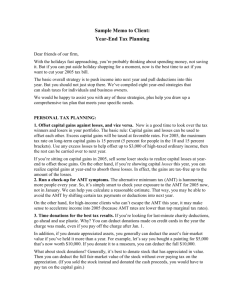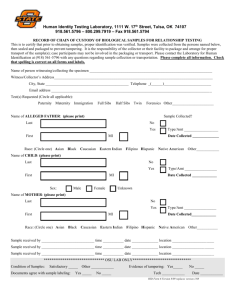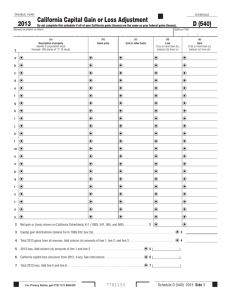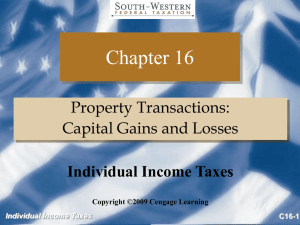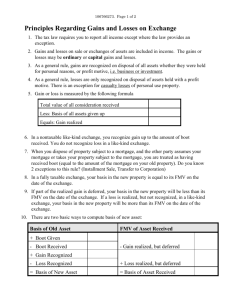Capital gains
advertisement
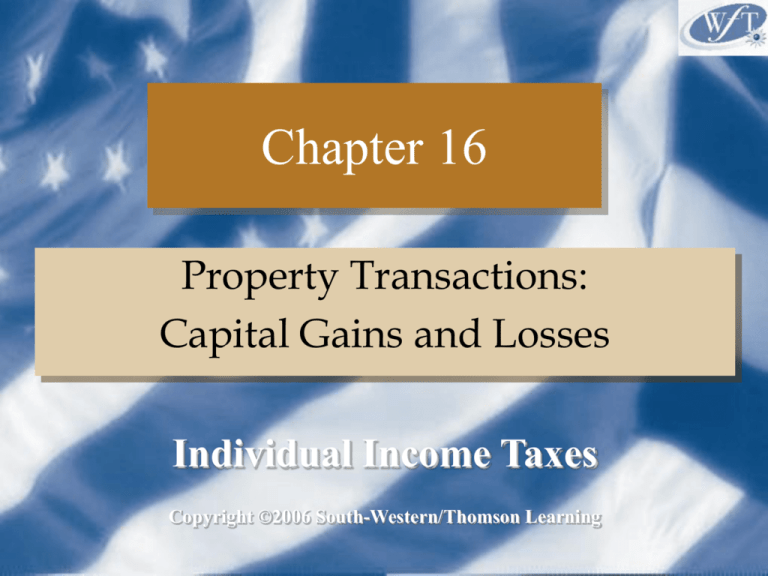
Chapter 16 Property Transactions: Capital Gains and Losses Individual Income Taxes Copyright ©2006 South-Western/Thomson Learning Taxation of Capital Gains and Losses • Capital gains and losses must be separated from other types of gains and losses for two reasons: – Long-term capital gains may be taxed at a lower rate than ordinary gains – A net capital loss is only deductible up to $3,000 per year Individual Income Taxes C16 - 2 Proper Classification of Gains and Losses • Depends on three characteristics: – The tax status of the property • Capital asset, §1231 asset, or ordinary asset – The manner of the property’s disposition • By sale, exchange, casualty, theft, or condemnation – The holding period of the property • Short term and long term Individual Income Taxes C16 - 3 Capital Assets (slide 1 of 6) • §1221 defines capital assets as everything except: – Inventory (stock in trade) – Notes and accounts receivables acquired from the sale of inventory or performance of services – Realty and depreciable property used in trade or business (§1231 assets) Individual Income Taxes C16 - 4 Capital Assets (slide 2 of 6) • §1221 defines capital assets as everything except (cont’d): – Creative works (e.g., art, music, copyrights) when created by taxpayer (or for which taxpayer takes a carryover basis from the creator) – Certain publications of U.S. government Individual Income Taxes C16 - 5 Capital Assets (slide 3 of 6) • Thus, capital assets are: – Assets held for investment (e.g., stocks, bonds, land) – Personal use assets (e.g., residence, car) – Miscellaneous assets selected by Congress Individual Income Taxes C16 - 6 Capital Assets (slide 4 of 6) • Dealers in securities – In general, investment assets are the inventory of securities dealers, thus ordinary assets – However, a dealer can identify securities as an investment and receive capital gain treatment • Clear identification must be made on the day of acquisition Individual Income Taxes C16 - 7 Capital Assets (slide 5 of 6) • Real property subdivided for sale – Taxpayer may receive capital gain treatment on the subdivision of real estate if the following requirements are met: • • • • • Taxpayer is not a corporation Taxpayer is not a real estate dealer No substantial improvements made to the lots Taxpayer held the lots for at least 5 years Capital gain treatment occurs until the year in which the sixth lot is sold Individual Income Taxes C16 - 8 Capital Assets (slide 6 of 6) • Nonbusiness bad debts – A nonbusiness bad debt is treated as a shortterm capital loss in the year it becomes worthless Individual Income Taxes C16 - 9 Sale or Exchange (slide 1 of 11) • Recognition of capital gains and losses generally requires a sale or exchange of assets • Sale or exchange is not defined in the Code • There are some exceptions to the sale or exchange requirement Individual Income Taxes C16 - 10 Sale or Exchange–Worthless Securities (slide 2 of 11) • A security that becomes worthless creates a deductible capital loss without being sold or exchanged • The Code sets an artificial sale date for the securities on the last day of the year in which worthlessness occurs Individual Income Taxes C16 - 11 Sale or Exchange (slide 3 of 11) • Worthless securities example: – Calendar year taxpayer purchased stock on December 5, 2004 – The stock becomes worthless on April 5, 2005 – The loss is deemed to have occurred on December 31, 2005 • The result is a long-term capital loss Individual Income Taxes C16 - 12 Sale or Exchange–Retirement of Corporate Obligations (slide 4 of 11) • Collection of the redemption value of corporate obligations (e.g., bonds payable) is treated as a sale or exchange and may result in a capital gain or loss – OID amortization increases basis and reduces gain on disposition or retirement Individual Income Taxes C16 - 13 Sale or Exchange–Options (slide 5 of 11) • Sale of an option by grantee results in capital gain or loss if the option property is a capital asset to the grantee • Lapse of an option on a capital asset is considered a sale or exchange resulting in a capital loss for the grantee of the option – For the grantor of an option, the lapse creates • Short-term capital gain, if the option was on stocks, securities, commodities or futures • Otherwise, ordinary income Individual Income Taxes C16 - 14 Sale or Exchange–Options (slide 6 of 11) • Exercise of an option by a grantee increases the gain (or reduces the loss) to the grantor from the sale of the property – Gain is ordinary or capital depending on the tax status of the property • Grantee adds the cost of the option to the basis of the property acquired Individual Income Taxes C16 - 15 Sale or Exchange–Patents (slide 7 of 11) • When all substantial rights to a patent are transferred by a holder to another, the transfer produces long-term capital gain or loss – The holder of a patent must be an individual, usually the creator, or an individual who purchases the patent from the creator before the patented invention is reduced to practice Individual Income Taxes C16 - 16 Sale or Exchange–Franchises, Trademarks, and Trade Names (slide 8 of 11) • The licensing of trade names, trademarks, and other intangibles is generally not considered a sale or exchange of a capital asset – Therefore, ordinary income results to transferor • Exception: Capital gain (loss) may result if the transferor does not retain any significant power, right, or continuing interest Individual Income Taxes C16 - 17 Sale or Exchange–Franchises, Trademarks, and Trade Names (slide 9 of 11) • Significant powers, rights, or continuing interests include: – – – – Control over assignment Quality of products and services Sale or advertising of other products or services The right to require that substantially all supplies and equipment be purchased from the transferor – The right to terminate the franchise at will, and – The right to substantial contingent payments Individual Income Taxes C16 - 18 Sale or Exchange–Franchises, Trademarks, and Trade Names (slide 10 of 11) • Noncontingent payments are ordinary income to the transferor – The franchisee capitalizes the payments and amortizes them over 15 years • Contingent payments are ordinary income for the franchisor and an ordinary deduction for the franchisee Individual Income Taxes C16 - 19 Sale or Exchange–Lease Cancellation Payments (slide 11 of 11) • Lessee treatment – Treated as received in exchange for underlying leased property • Capital gain results if asset leased was a capital asset (e.g., personal use ) • Ordinary income results if asset leased was an ordinary asset (e.g., used in lessee’s business) • Lessor treatment – Payments received are ordinary income (rents) Individual Income Taxes C16 - 20 Holding Period (slide 1 of 3) • Short-term – Asset held for 1 year or less • Long-term – Asset held for more than 1 year • Holding period starts on the day after the property is acquired and includes the day of disposition Individual Income Taxes C16 - 21 Holding Period (slide 2 of 3) • Nontaxable Exchanges – Holding period of property received includes holding period of former asset if a capital or §1231 asset • Transactions involving a carryover basis – Former owner’s holding period tacks on to present owner’s holding period if a nontaxable transaction and basis carries over • Inherited property is always treated as long term no matter how long it is held by the heir Individual Income Taxes C16 - 22 Holding Period (slide 3 of 3) • Short sales – Taxpayer sells borrowed securities and then repays the lender with substantially identical securities – Gain or loss is not recognized until the short sale is closed – The holding period for a short sale is determined by how long the property used for repayment is held Individual Income Taxes C16 - 23 Tax Treatment of Capital Gains and Losses (slide 1 of 7) • Noncorporate taxpayers – Capital gains and losses must be netted by holding period • Short-term capital gains and losses are netted • Long-term capital gains and losses are netted • If possible, long-term gains or losses are then netted with short-term gains or losses – If the result is a loss: – The capital loss deduction is limited to a maximum deduction of $3,000 – Unused amounts retain their character and carryforward indefinitely Individual Income Taxes C16 - 24 Tax Treatment of Capital Gains and Losses (slide 2 of 7) • Noncorporate taxpayers (cont’d) – If net from capital transactions is a gain, tax treatment depends on holding period • Short-term (assets held 12 months or less) – Taxed at ordinary income tax rates • Long-term (assets held more than 12 months) – An alternative tax calculation is available using preferential tax rates Individual Income Taxes C16 - 25 Tax Treatment of Capital Gains and Losses (slide 3 of 7) • Noncorporate taxpayers (cont’d) – Net long-term capital gain is eligible for one or more of four alternative tax rates: 5%, 15%, 25%, and 28% • The 25% rate applies to unrecaptured §1250 gain and is related to gain from disposition of §1231 assets • The 28% rate applies to collectibles • The 5%/15% rates apply to any remaining net longterm capital gain Individual Income Taxes C16 - 26 Tax Treatment of Capital Gains and Losses (slide 4 of 7) • Collectibles, even though they are held long term, are subject to a 28% alternative tax rate • Collectibles include: – – – – – – – Any work of art Any rug or antique Any metal or gem Any stamp Any alcoholic beverage Most coins Any historical objects (documents, clothes, etc.) Individual Income Taxes C16 - 27 Tax Treatment of Capital Gains and Losses (slide 5 of 7) • Qualified dividend income paid from current or acc. E & P is eligible for the 5%/15% long-term capital gain rates – After determining net capital gain or loss, qualified dividend income is added to the net long-term capital gain portion of the net capital gain and is taxed as 5%/15% gain • If there is a net capital loss, it is still deductible for AGI – Limited to $3,000 per year with the remainder of the loss carrying over • In this case, the qualified dividend income is still eligible to be treated as 5%/15% gain in the alternative tax calculation – It is not offset by the net capital loss Individual Income Taxes C16 - 28 Tax Treatment of Capital Gains and Losses (slide 6 of 7) • When there are both short and long-term capital gains and losses, a complicated ordering procedure is required because the long-term capital gains may be taxed at various rates Individual Income Taxes C16 - 29 Tax Treatment of Capital Gains and Losses (slide 7 of 7) • Corporate taxpayers – Differences in corporate capital treatment • There is a NCG alternative tax rate of 35 % – Since the max corporate tax rate is 35 %, the alternative tax is not beneficial • Net capital losses can only offset capital gains (i.e., no $3,000 deduction in excess of capital gains) • Net capital losses are carried back 3 years and carried forward 5 years as short-term losses Individual Income Taxes C16 - 30 If you have any comments or suggestions concerning this PowerPoint Presentation for West Federal Taxation, please contact: Dr. Donald R. Trippeer, CPA TRIPPEDR@oneonta.edu SUNY Oneonta Individual Income Taxes C16 - 31
